APHRODITE ESTATE
Greek Name
Αφροδιτη
Transliteration
Aphroditê
Latin Spelling
Aphrodite
Translation
Venus
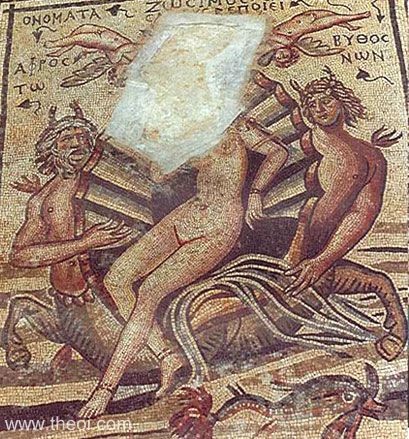
APHRODITE was the Olympian goddess of love, beauty, pleasure and procreation.
This page describes the goddess' attributes, estate, and sacred plants and animals. Her attributes included the winged godling Eros, a mirror, cockle shell, dove, apple and myrtle wreath. Her sacred plants and animals included the rose, myrtle, apple, dove and goose.
(1) ESTATE & ATTRIBUTES
DOVE-DRAWN CHARIOT Aphrodite's jewel-encrusted, golden chariot was drawn through the sky by a team of doves.
TRITON-DRAWN CHARIOT Aphrodite was a goddess of the sea as well as the heavens, and according to one author, she possessed a sea-going chariot drawn by fish-tailed Tritones.
CLOTHING & JEWELLERY Aphrodite clothed herself in rich, brightly-coloured clothing and adorned herself with fabulous jewellery.
MAGICAL GIRDLE The magical girdle (or cestus) of Aphrodite was woven with the irrestistable powers of love and desire.
PALACE Aphrodite's palace stood either upon Mt Olympos itself or in the heaven's high above the famous mountain.
(2) SACRED PLANTS AND ANIMALS
DOVE The affectionate white or turtle-dove was the bird of love, was a bird sacred to the goddess Aphrodite. Doves were said to draw her heavenly chariot, and the Syrian Aphrodite Ashtarte was said to have been hatched from an egg nursed by doves.
GOOSE The white goose was sacred to Aphrodite. She was often depicted riding one side-saddle.
SPARROW The sparrow was a bird sacred to the goddess Aphrodite.
SWAN Usually associated with Apollon, in art, Aphrodite also occasionally appears riding on the back of a swan (in place of her usual goose).
FISH The fish was said to be sacred to Aphrodite, deriving from the Syrian myth of the birth of Ashtarte, in which the goddess was borne from an egg carried to the banks of the River Euphrates by fish.
SHELLFISH Shellfish were regarded as sacred to the goddess Aphrodite and were so regarded as aphrodisiacs - from the scallop or cockle, to the mussel and nerites shell. The pearl was therefore also her stone.
COCKLE The cockle-shell was sacred to Aphrodite, who was often depicted emerging from one in her birth scene. The half opened shell represented a woman's genitalia.
HARE The hare was regarded as an animal sacred to Aphrodite and Eros because of its high libido. Live hares were often presented as a gift of love.
SWINE The pig was an animal believed to be offensive to the goddess Aphrodite, for it was a wild swine which gored to death her beloved Adonis. Pig-sacrifice was therefore prohibited in her cult, except in Kypros and Argos where pigs were offered to assuage her grief for Adonis.
APPLE The apple and apple-tree were sacred to the goddess Aphrodite. She was awarded the prize of the golden apple from Paris of Troy and also bestowed golden apples upon Hippomenes in his contest to win Atalanta.
POMEGRANATE The pomegranate was sacred to Aphrodite who was said to have first planted it on the island of Kypros. The fruit symbolised female fertility and the marital loss of virginity with the consumation of marriage (from both its red stains and rich seeds).
LETTUCE The lettuce was said to have been sacred to Aphrodite, for she lay the dead body of Adonis in a bed of these plants. It was believed to cause impotence in men.
MYRTLE & MYRRH The myrtle-tree (Greek myrrhina) and myrrh-bush (Greek smyrna) were sacred to Aphrodite, because it was from one these plants that her beloved Adonis was born (the metamorphosed form of his mother Myrrha or Smyrna).
ANEMONE The red anemone was a flower sacred to Aphrodite. It was said to have sprung from the blood of her dying lover Adonis.
ROSE The red rose was sacred to Aphrodite. It was said to have blushed or been stained red when Aphrodite cut her feet on its thorns rushing to the aide of her dying lover Adonis.
PEARL The sea-born pearl was the regarded as the stone of love, and so sacred to the goddess Aphrodite.
CLASSICAL LITERATURE QUOTES
DOVE-DRAWN CHARIOT OF APHRODITE
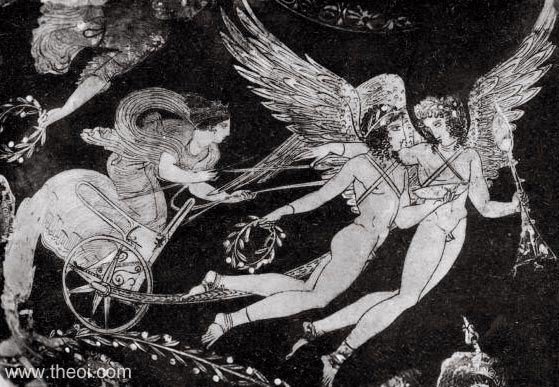
Orphic Hymn 55 to Aphrodite (trans. Taylor) (Greek hymns C3rd B.C. to 2nd A.D.)
:
"[Aphrodite] To drive thy rapid two-yoked car of gold."
Ovid, Metamorphoses 9. 708 ff (trans. Melville) (Roman epic C1st B.C. to C1st A.D.)
:
"Cytherea [Aphrodite] was riding in her dainty chariot, winged by her swans, across the middle air making
for Cyprus, when she heard afar Adonis' dying groans, and thither turned her snowy birds."
Ovid, Metamorphoses 14. 597 ff :
"[Aphrodite] carried by her doves across the sky, reached the Laurentian coast."
Statius, Silvae 1. 2. 51 (trans. Mozley) (Roman poetry C1st A.D.) :
"She [Aphrodite] raised her starry limbs, and passing the proud threshold of her chamber called to the
reign her Amyklaian doves. Amor [Eros, love] harnesses them, and seated on the jewelled car bears his mother
rejoicing through the clouds."
Apuleius, The Golden Ass 6. 6 ff (trans. Walsh) (Roman novel C2nd A.D.) :
"Venus [Aphrodite] . . . ordered her carriage to be prepared; Vulcanus [Hephaistos] had lovingly applied
the finishing touches to it with elaborate workmanship, and had given it to her as a wedding-present before her
initiation into marriage. The thinning motion of his file had made the metal gleam; the coach's value was
measured by the gold it had lost. Four white doves emerged from the large herd stabled close to their mistress's
chamber. As they strutted gaily forward, turning their dappled necks from side to side. They submitted to the
jewelled yoke. They took their mistress aboard and delightedly mounted upwards. Sparrows sported with the
combined din of their chatter as they escorted the carriage of the goddess, and the other birds, habitually
sweet songsters, announced the goddess's approach with the pleasurable sound of their honeyed tunes. The clouds
parted, and Caelus (Heaven) [Ouranos] admitted his daughter; the topmost region delightedly welcomed the
goddess, and the tuneful retinue of mighty Venus had no fear of encounter with eagles or of plundering
hawks."
In ancient Greek vase-painting the chariot of Aphrodite was sometimes depicted drawn by a pair of Erotes (winged Love-Gods).
TRITON-DRAWN COCKLE-SHELL OF APHRODITE
Apuleius, The Golden Ass 4. 31 ff (trans. Walsh) (Roman novel C2nd A.D.) :
"Then she [Venus-Aphrodite] made for the nearest shore lapped by the waves. With rosy feet she mounted the
surface of the rippling waters, and lo and behold, the bright surface of the sea-depths was becalmed. At her
first intimation, her retinue in the deep performed her wishes [the various sea-gods and goddesses join her
company] . . . Bands of Tritoni sported here and there on the waters, one softly blowing on his echoing shell,
another fending off with silk parasol the heat of the hostile sun, a third holding a mirror before his
mistress's face, while others, yoked in pairs to her chariot, swam below. This was the host of Venus' companions
as she made for the Oceanus."
For MORE information on these Tritons see IKHTHYOKENTAUROI
CLOTHING, PERFUME & JEWELLERY OF APHRODITE
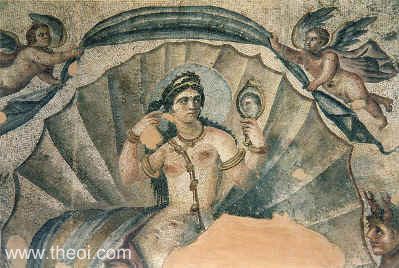
Homer, Iliad 5. 337 ff (trans. Lattimore) (Greek epic C8th B.C.) :
"About her [Aphrodite's] beloved son [Aineias wounded during the Trojan War] came streaming her white arms,
and with her white robe thrown in a fold in front she shielded him, this keeping off the throne weapons lest
some fast-mounted Danaan strike the bronze spear through his chest . . . The immortal robe that the very
Kharites had woven for her [Aphrodite]."
Homer, Odyssey 18. 193 ff (trans. Shewring) (Greek epic C8th B.C.) :
"[Athene] cleansed the lovely features with the fragrant balm that Kytherea [Aphrodite] puts on when she
enters the bewitching circle of dancing Kharites, and with this she made her skin more white than ivory newly
sawn."
Homeric Hymn 6 to Aphrodite (trans. Evelyn-White) (Greek epic C7th to 4th B.C.)
:
"[Aphrodite at her birth was carried by the winds to Kypros] and there the gold-filleted Horai (Seasons)
welcomed her joyously. They clothed her with heavenly garments: on her head they put a fine, well-wrought crown
of gold, and in her pierced ears they hung ornaments of orichalc and precious gold, and adorned her with golden
necklaces over her soft neck and snow-white breasts, jewels which the gold-filleted Horai wear themselves."
Homeric Hymn 5 to Aphrodite 58 ff :
"She [Aphrodite] went to Kypros, to Paphos, where her precinct is and fragrant altar, and passed into her
sweet-smelling temple. There she went in and put to the glittering doors, and there the Kharites (Graces) bathed
her with heavenly oil such as blooms upon the bodies of the eternal gods - oil divinely sweet, which she had by
her, filled with fragrance. And laughter-loving Aphrodite put on all her rich clothes . . . decked herself with
gold . . . For she was clad in a robe out-shining the brightness of fire, a splendid robe of gold, enriched with
all manner of needlework, which shimmered like the moon over her tender breasts, a marvel to see. Also she wore
twisted brooches and shining earrings in the form of flowers; and round her soft throat were lovely
necklaces."
Stasinus of Cyprus or Hegesias of Aegina, Cypria Fragment 6 (from Athenaeus 15. 682)
(trans. Evelyn-White) (Greek epic C7th or 6th B.C.) :
"She [Aphrodite] clothed herself with garments which the Kharites (Graces) and Horai (Hours) had made for
her and dyed in flowers of spring--such flowers as the Horai wear--in crocus and hyacinth and flourishing violet
and the rose's lovely bloom, so sweet and delicious, and heavenly buds, the flowers of the narcissus and lily.
In such perfumed garments is Aphrodite clothed at all seasons."
For the MYTH of Aphrodite's sacred beauty cream see PSYKHE
MAGIC GIRDLE OF APHRODITE
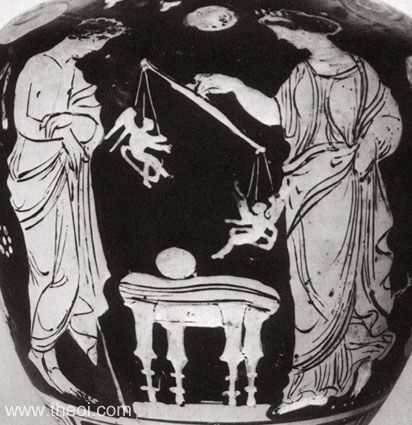
The magical girdle of Aphrodite had the power to inspire the passion of desire. Hera, in her role as the goddess of marriage, occassionally borrowed it from Aphrodite to reunite quarrelling spouses in love and to inspire the bridal contests of suitors.
Homer, Iliad 14. 159 & 187 ff (trans. Lattimore) (Greek epic C8th B.C.)
:
"Lady ox-eyed Hera was divided in purpose as to how she could beguile the brain in Zeus . . . And to her
mind this thing appeared to be the best counsel, to array herself in loveliness, and go down to Ida, and perhaps
he might be taken with desire to lie in love with her next her skin . . .
[She] called aside Aphrodite to come away from the rest of the gods, and spoke a word to her : ‘. . . Give
me loveliness and desirability, graces with which you overwhelm mortal men, and all the immortals. Since I go
now to the ends of the generous earth, on a visit to Okeanos, whence the gods have risen, and Tethys our mother
who brought me up kindly in their own house . . . I shall go to visit these, and resolve their division of
discord, since now for a long time they have stayed apart from each other and from the bed of love, since
rancour has entered their feelings. Could I win over with persuasion the dear heart within them and bring them
back to their bed to be merged in love with each other I shall be forever called honoured by them, and
beloved.’
Then in turn Aphrodite Philomeides (the laughing) answered her : ‘I cannot, and I must not deny this thing
that you ask for, you, who lies in the arms of Zeus, since he is our greatest.’
She spoke, and from her breasts unbound the elaborate, pattern-pierced zone (himas), and on it are
figured all beguilement (philotes), and loveliness is figured upon it, and passion of sex
(himeros) is there, and the whispered endearment (oaristos) that steals the heart away even
from the thoughtful. She put this in Hera's hands, and called her by name and spoke to her : ‘Take this
zone, and hide it away in the fold of your bosom. It is elaborate, all things are figured therein. And I think
whatever is your heart's desire shall not go unaccomplished.’"
Ptolemy Hephaestion, New History Book 4 (summary from Photius, Myriobiblon 190)
(trans. Pearse) (Greek mythographer C1st to C2nd A.D.) :
"The author [Hephaestion] speaks of the embroidered belt [the cestus] which Hera received from Aphrodite
and gave to Helene [either for the contest of the suitors or her introduction to Paris]: it was stolen by
Helene's servant, Astyanassa and recovered from her by Aphrodite."
Philostratus the Younger, Imagines 8 (trans. Fairbanks) (Greek rhetorician C3rd A.D.)
:
"[From a description of a painting depicting Aphrodite :] The painting shows the
‘laughter-loving’ disposition caused by the magic of her girdle."
Apuleius, The Golden Ass 2. 8 ff (trans. Walsh) (Roman novel C2nd A.D.) :
"Venus [Aphrodite] . . . wearing that belt of hers around her waist."
Colluthus, Rape of Helen 15 ff (trans. Mair) (Greek poetry C5th to 6th A.D.)
:
"For spear I [Aphrodite] have, as it were, a swift lance, the honeyed girdle of the Erotes (Loves)! I have
my girdle, I ply my goad, I raise my bow: even that girdle, whence women catch the sting of my desire, and
travail often-times, but not unto death."
Colluthus, Rape of Helen 155 ff :
"[At the contest of the goddesses for the golden apple :] Kypris [Aphrodite] lifted up her deep-bosomed
robe and bared her breast to the air and had no shame. And lifting with her hands the honeyed girdle of the
Erotes (Loves) she bared all her bosom and heeded not her breasts. And smilingly she spake to the herdsman
[Paris]."
Nonnus, Dionysiaca 41. 20 ff (trans. Rouse) (Greek epic C5th A.D.) :
"[When Aphrodite was born from the sea-foam:] Coming up with the goddess there was that embroidered strap
which ran round her loins like a belt, set about the queen's body in a girdle of itself."
Nonnus, Dionysiaca 3. 400 ff (trans. Rouse) (Greek epic C5th A.D.) :
"Tricky-minded Aphrodite girt her body in the heart-bewitching cestus-belt, and clothing herself in the
love-robe of Peitho (Persuasion)."
Nonnus, Dionysiaca 5. 88 ff :
"Soon Harmonia yoked by the cestus-girdle [of Aphrodite] that guides wedded desire, carried in her womb the
seed of many children whom she brought forth soon one by one."
Nonnus, Dionysiaca 32. 10 ff :
"She [Hera] bound the unaccustomed cestus [that Aphrodite had loaned her] about and about her flanks . . .
She came near to Zeus. And when Zeus Highest and Mightiest saw her, the goading cestus whipt him to hotter love.
As Zeus looked upon her his eyes were enslaved."
Nonnus, Dionysiaca 33. 4 ff :
"[Aphrodite addresses the Kharis Pasithea :] ‘Has Eros perhaps flicked you also with the cestus, like
Eos (the Dawn) once before?’"
Nonnus, Dionysiaca 42. 98 ff :
"When I hear that your mother is Kypris, my only wonder is that her cestus has left you uncharmed . . .
Flogged by the blows of the cestus [i.e. by desire]."
Nonnus, Dionysiaca 42. 378 ff :
"Obey the cestus girdle born with Paphia [Aphrodite]!"
Nonnus, Dionysiaca 48. 264 ff :
"Eros (Love) . . . caught a lioness alive with the all-bewitching cestus."
Suidas s.v. Kythereia (trans. Suda On Line) (Byzantine Greek lexicon C10th A.D.)
:
"She [Aphrodite] has love hidden (keuthomenon) within herself, which she sends to all; for through
her charmed girdle she has the power."
PALACE OF APHRODITE
Apollonius Rhodius, Argonautica 3. 36 ff (trans. Rieu) (Greek epic C3rd B.C.)
:
"The palace of Aphrodite [on Mount Olympos], which her lame consort Hephaistos had built for her when he
took he as his bride from the hands of Zeus. They [Hera and Athene] entered the courtyard and paused below the
veranda of the room where the goddess slept with her lord and master."
Valerius Flaccus, Argonautica 6. 455 ff (trans. Mozley) (Roman epic C1st A.D.)
:
"Seeks she [Hera] Venus' [Aphrodite's] bower and the garlands ever fresh that deck her abode. At the sight
of her the goddess straightway springs from her high-piled couch, and all the troop of winged Amores [Erotes the
Loves]."
Statius, Silvae 1. 2. 51 (trans. Mozley) (Roman poetry C1st A.D.) :
"Once on a time, where the milky region is set in a tranquil heaven, lay kindly Venus [Aphrodite] in her
bower, whence night had but lately fled, faint in the rough embrace of her Getic lord [Ares]. About the posts
and pillows of her couch swarm a troop of tender Amores [Erotes the Loves] . . . Weary she lies upon her
cushions."
SACRED PLANTS & FLOWERS
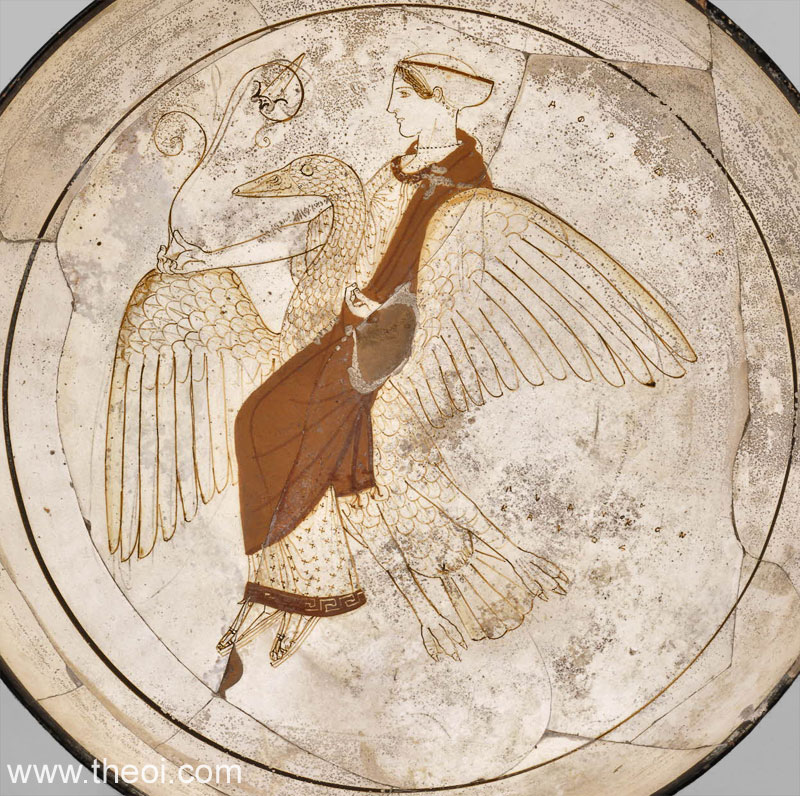
I. ROSE (Greek rhodon)
The Anacreontea, Fragment 35 (trans. Campbell, Vol. Greek Lyric II) (Greek lyric
B.C.) :
"The soft rose. It is the breath of the gods and the joy of mortals, the glory of the Kharites (Graces) in
spring-time, the delight of the Erotes (Loves) with their rich garlands and of Aphrodite; it is a subject for
poetry and the graceful plant of the Mousai."
The Anacreontea, Fragment 44 :
"Let us mix the Erotes' rose with Dionysos : let us fasten on our brows the rose with its lovely petals and
drink, laughing gently. Rose, finest of flowers, rose, darling of spring, rose, delight of the gods also, rose
with which Kythere's [Aphrodite's] son [Eros] garlands his lovely curls when he dances with the Kharites."
Ibycus, Fragment 288 (trans. Campbell, Vol. Greek Lyric III) (Greek lyric C6th B.C.)
:
"Kypria [Aphrodite] and soft-lidded Peitho nursed you among rose-blossoms."
Pausanias, Description of Greece 6. 24. 7 (trans. Jones) (Greek travelogue C2nd A.D.)
:
"The rose and the myrtle are sacred to Aphrodite and connected with the story of Adonis."
Apuleius, The Golden Ass 4. 2 ff (trans. Walsh) (Roman novel C2nd A.D.) :
"I saw at some distance a valley shaded by a leafy wood. Glinting among diverse smaller plants and the most
luxuriant shrubbery were some bright roses of ruddy hue . . . that grove seemed to me to be the abode of Venus
[Aphrodite] and the Gratiae [Kharites]; in its shady recesses that delightful blossom shone out with its
brightness of royal crimson."
Nonnus, Dionysiaca 32. 10 ff (trans. Rouse) (Greek epic C5th A.D.) :
"That herb of passion [the myrtle] which Kythereia [Aphrodite] loves as much as the rose, as much as the
anemone."
Nonnus, Dionysiaca 13. 333 ff :
"Hanging in the bridal chamber golden fruit [apples] . . . in place of the wedding-roses."
Suidas s.v. Anthemon (trans. Suda On Line) (Byzantine Greek lexicon C10th A.D.)
:
"Zeuxis the painter drew in the temple of Aphrodite [at Athens] a most youthful Eros (Love), encircled with
roses."
II. ANEMONE (Greek anenome)
Ovid, Metamorphoses 10. 705 ff (trans. Melville) (Roman epic C1st B.C. to C1st A.D.)
:
"[Aphrodite laments the death of her love Adonis :] ‘Your blood shall change into a flower . . . and
ere an hour had passed a blood-red flower arose, like the rich bloom of pomegranates . . . yet is its beauty
brief, so lightly cling it petals, fall so soon, when the winds [Greek anemoi] blow that give the
flower [anemone] its name.’"
Nonnus, Dionysiaca 32. 10 ff (trans. Rouse) (Greek epic C5th A.D.) :
"That herb of passion [the myrtle] which Kythereia [Aphrodite] loves as much as the rose, as much as the
anemone, which she wears when she is about to mingle her love with Myrrha's son [Adonis]."
For the MYTH of the death of Adonis see Aphrodite Loves: Adonis
III. MYRTLE & MYRRH (Greek myrrhina and smyrna)
Both plants were connected with the birth of Adonis (in two alternate versions of the story).
Aesop, Fables 205 (from Phaedrus 3. 17) (trans. Gibbs) (Greek fable C6th B.C.)
:
"Once upon a time, the gods selected the trees which they wished to adopt as their own. Jove [Zeus] chose
the oak tree, while Venus [Aphrodite] preferred the myrtle tree, Phoebus [Apollon] the laurel."
Pausanias, Description of Greece 6. 24. 7 (trans. Jones) (Greek travelogue C2nd A.D.)
:
"The rose and the myrtle are sacred to Aphrodite and connected with the story of Adonis."
Pausanias, Description of Greece 2. 32. 3 :
"Here [in Aphrodite's temple at Troizenos] there still grew the myrtle, with its leaves . . . pierced with
holes."
Pausanias, Description of Greece 5. 13. 7 :
"[There is] an image of Aphrodite in Temnos [in Elis] made of a living myrtle-tree."
Virgil, Georgics 1.27 ff (trans. Fairclough) (Roman bucolic C1st B.C.) :
"[Caesar is praised as a descendant of Aeneas:] Wreathing your brows with your mother's [Aphrodite's]
myrtle."
Virgil, Georgics 2. 64 :
"Paphian myrtles." [N.B. The Paphian is Aphrodite.]
Nonnus, Dionysiaca 32. 10 ff (trans. Rouse) (Greek epic C5th A.D.) :
"About her hair she twined that herb of passion [the myrtle] which Kythereia [Aphrodite] loves as much as
the rose, as much as the anemone."
For the MYTH of Aphrodite & myrtle or myrrh see:
(1) Aphrodite Loves: Adonis (boy born of the tree)
(2) Aphrodite Wrath: Myrrha Smyrna (transformed into the tree by
Aphrodite)
IV. APPLE (Greek melon)
Pausanias, Description of Greece 2. 10. 4 (trans. Jones) (Greek travelogue C2nd A.D.)
:
"[The statue of Aphrodite in Sikyon is] carrying in one hand a poppy and in the other an apple."
Philostratus the Elder, Imagines 1. 6 (trans. Fairbanks) (Greek rhetorician C3rd
A.D.) :
"[Description of an ancient Greek painting :] The Erotes (Loves) bring [to Aphrodite] first-fruits of the
apples, and gathering around they pray to her that their apple-orchard may prosper."
Nonnus, Dionysiaca 13. 333 ff (trans. Rouse) (Greek epic C5th A.D.) :
"Kypris [Aphrodite] together with the Erotes (Loves) decked out a fine bed for the wedding, hanging in the
bridal chamber golden fruit [apples] from the Nymphai's garden, a worthy lovegift for the bride; rich clusters
of their leaves Harmonia and Kadmos twined through their hair, amid the abundance of their bridechamber, in
place of the wedding-roses. Still more dainty the bride appeared wearing these golden gifts, the boon of golden
Aphrodite."
Suidas s.v. Rhamnousia Nemesis (trans. Suda On Line) (Byzantine Greek lexicon C10th
A.D.) :
"[The statue of Nemesis at Rhamnousos was] modelled on the appearance of Aphrodite; that is why she held a
sprig from an apple-tree."
For MYTHS of Aphrodite and the apple see:
(1) Aphrodite Favour: Hippomenes (given golden apples by the
goddess)
(2) THE JUDGEMENT OF PARIS (goddess awarded prize of a golden apple)
V. LETTUCE (Greek thridax)
Athenaeus, Deipnosophistae 2. 69b-d (trans. Gullick) (Greek rhetorician C2nd to 3rd
A.D.) :
"Nikandros of Kolophon [C2nd BC grammarian C2nd B.C.], in the second book of his Dialect Lexicon,
explains the word brenthis as the Cyprian term for lettuce; in this Adonis sought refuge from the wild
boar which killed him . . . Kallimakhos [grammarian C3rd B.C.], too, says that Aphrodite hid Adonis in a
lettuce-bed, since the poets mean by this allegory that constant eating of lettuce produces impotence. So also
Euboulos, in the Defectives, says : ‘Don't put lettuce on the table before me, wife, or you will
have only yourself to blame. For in that plant, the story goes, Kypris [Aphrodite], once laid out Adonis when he
died; therefore it is dead men's food.’ And Kratinos [comic poet C6th B.C.] says that Aphrodite, when she
fell in love with Phaon, hid him away in ‘fair lettuce-beds.’"
For the MYTH of the death of Adonis see Aphrodite Loves: Adonis
VI. POMEGRANATE (Greek rhoa)
The pomegranate was sacred to Aphrodite in Kypros. The fruit symbolised the consumation of marriage and the loss of female virginity (for example, in the story of Persephone). It was also believed to work as a natural abortifaction agent. The fruit was also sacred to Hera as the goddess of marriage.
Athenaeus, Deipnosophistae 3. 84c (trans. Gullick) (Greek rhetorician C2nd to 3rd
A.D.) :
"Eriphos in the Meliboia . . .: A: And here are the pomegranates. B: How nice they are! A: Ay, for they say
this was the one and only tree that Aphrodite planted in Kypros. B: Worshipful Berbeia!"
For MORE information and pictures of sacred plants see FLORA OF MYTH
SACRED BIRDS & ANIMALS
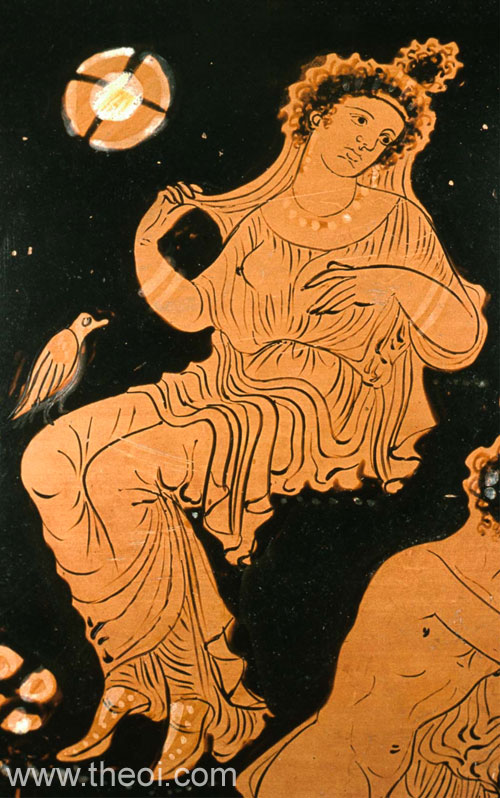
I. TURTLE-DOVE & SPARROW (Greek trugon and struthous)
Aelian, On Animals 10. 33 (trans. Schofield) (Greek natural history C2nd to 3rd A.D.)
:
"White Turtle-doves are often to be seen. These, they say, are sacred to Aphrodite and Demeter."
Pseudo-Hyginus, Fabulae 197 (trans. Grant) (Roman mythographer C2nd A.D.)
:
"Into the Euphrates River an egg of wonderful size is said to have fallen, which the fish rolled to the
bank. Doves sat on it, and when it was heated, it hatched out Venus, who was later called the Syrian goddess.
Since she excelled the rest in justice and uprightness, by a favour granted by Jove [Zeus], the fish were put
among the number of the stars, and because of this the Syrians do not eat fish or doves, considering them as
gods."
Ovid, Metamorphoses 13. 673 ff (trans. Melville) (Roman epic C1st B.C. to C1st A.D.)
:
"Birds your [Ares'] consort [Aphrodite] loves . . . snow-white doves."
Ovid, Metamorphoses 14. 597 ff :
"[Aphrodite] carried by her doves across the sky."
Apuleius, The Golden Ass 6. 6 ff (trans. Walsh) (Roman novel C2nd A.D.) :
"Four white doves . . . submitted to the jewelled yoke [of the chariot of Aphrodite]. They took their
mistress aboard and delightedly mounted upwards. Sparrows sported with the combined din of their chatter as they
escorted the carriage of the goddess, and the other birds, habitually sweet songsters, announced the goddess's
approach with the pleasurable sound of their honeyed tunes."
Nonnus, Dionysiaca 33. 4 ff (trans. Rouse) (Greek epic C5th A.D.) :
"[Aphrodite addresses Eros :] ‘Honour my bridesmaid bird of love [the dove] and yours, the herald of
lifelong wedding and happy hearts!’"
See also Dove-Drawn Chariot of Aphrodite (this page)
II. GOOSE
The goose was a bird of Aphrodite.
III. SWALLOW
Aelian, On Animals 10. 34 (trans. Schofield) (Greek natural history C2nd to 3rd A.D.)
:
"The Swallow is held sacred to the Theoi Khelidoi (Household Gods) and to Aphrodite, for she also is one of
them." [N.B. The swallow is sacred to the household gods because it is a bird that commonly builds its nest
in the eaves of houses.]
IV. FISH (Greek ikhthyes)
Pseudo-Hyginus, Fabulae 197 (trans. Grant) (Roman mythographer C2nd A.D.)
:
"Into the Euphrates River an egg of wonderful size is said to have fallen, which the fish rolled to the
bank. Doves sat on it, and when it was heated, it hatched out Venus, who was later called the Syrian goddess.
Since she excelled the rest in justice and uprightness, by a favour granted by Jove [Zeus], the fish were put
among the number of the stars, and because of this the Syrians do not eat fish or doves, considering them as
gods."
Pseudo-Hyginus, Astronomica 2. 30 :
"Fishes. Diognetus Erythraeus says that once Venus [Aphrodite] and her son Cupid [Eros] came in Syria to
the river Euphrates. There Typhon, of whom we have already spoken, suddenly appeared. Venus [Aphrodite] and her
son threw themselves into the river and there changed their forms to fishes, and by so doing this escaped
danger. So afterwards the Syrians, who are adjacent to these regions, stopped eating fish, fearing to catch them
lest with like reason they seem either to oppose the protection of the gods, or to entrap the gods
themselves."
Ovid, Metamorphoses 5. 319 ff (trans. Melville) (Roman epic C1st B.C. to C1st A.D.)
:
"Typhoeus, issuing from earth's lowest depths, struck terror in those heavenly hearts, and they all turned
their backs and fled . . . and the gods concealed themselves in spurious shapes . . . Venus [Aphrodite] became a
fish."
Ovid, Fasti 2. 458 ff (trans.Boyle) (Roman poetry C1st B.C. to C1st A.D.)
:
"Piscis, heaven's horses. They say that you and your brother (for your stars gleam together) ferried two
gods on your backs. Once Dione [Aphrodite], in flight from terrible Typhon (when Jupiter [Zeus] armed in
heaven's defence), reached the Euphrates with tiny Cupidos [Eros] in tow and sat by the hem of Palestine's
stream . . . Twin fish went underneath them; for which, you see, the present stars are named. Hence timid
Syrians think it wrong to serve up this species; they defile no mouths with fish."
For MORE information on the fish of Aphrodite see IKHTHYES
V. SHELLFISH
Shellfish were regarded as sacred to Aphrodite from the cockle-shell (in which she is depicted floating at her birth) to the mussel, clam and . Similarly the pearl was her sacred stone.
Athenaeus, Deipnosophistae 3. 88a (trans. Gullick) (Greek rhetorician C2nd to 3rd
A.D.) :
"Antigonos of Karystos, in his treatise on Diktion, says that this shell-fish [the ear-mussles] is called
‘Aphrodite's ear' by the Aiolians."
Nonnus, Dionysiaca 32. 10 ff (trans. Rouse) (Greek epic C5th A.D.) :
"The Indian stone of love [the pearl], offspring itself of the waters and akin to Aphrogeneia (the
Foamborn)."
For MYTH of Aphrodite & shellfish see:
(1) The Birth of Aphrodite (carried ashore in a scallop-shell)
(2) Aphrodite Loves: Nerites (boy transformed into a shellfish)
VI. HARE (Greek lagos)
Philostratus the Elder, Imagines 1. 6 (trans. Fairbanks) (Greek rhetorician C3rd
A.D.) :
"[Description of an ancient Greek painting :] Erotes are hunting down [a hare] . . . but there is no
shooting of arrows at the hare, since they are trying to catch it alive as an offering most pleasing to
Aphrodite. For you know, I imagine, what is said of the hare, that it possesses the gift of Aphrodite
[fertility] to an unusual degree. At any rate it is said of the female that while she suckles the young she has
borne, she bears another litter to share the same milk; forthwith she conceives again, nor is there any time at
all when she is not carrying young. As for the male, he not only begets offspring in the way natural to males,
but also himself bears young, contrary to nature. And perverted lovers have found in the hare a certain power to
produce love, attempting to secure the objects of their affection by a compelling magic art."
Aphrodite's son Eros was often depicted carrying a hare, as a symbol of unquenchable desire.
VII. SWINE (Greek hus)
Aphrodite had a curious relationship with the pig. The goddess supposedly hated the creature because her lover
Adonis had been gorged to death by a wild boar. Therefore arose the proverb 'he sacrificed a pig to Aphrodite'
used to refer to someone who gave an innappropriate or unwanted gift.
However, in Argos and Kypros at least, pigs were sacrificed to the goddess during the Hysteria (of the pigs)
festival. The sacrifice was probably to assuage her grief for the loss of Adonis, who was slain by a wild pig.
Aesop, Fables 197 (from Chambry 329) (trans. Gibbs) (Greek fable C6th B.C.)
:
"A sow and a dog were viciously arguing with one another. The sow, for her part, swore by Aphrodite that
she would tear the dog to pieces with her teeth. The dog replied ironically, ‘Yes indeed, you do well to
swear by Aphrodite! It's clear just how much she loves you, since she absolutely forbids anyone who has tasted
your filthy flesh to enter her temple.’ The sow retorted, ‘This is even more evidence of the
goddess's love for me, since she turns away anyone who has slain or mistreated me in any way. As for you, you
just smell bad, dead or alive!’"
Athenaeus, Deipnosophistae 3. 95f - 96a (trans. Gullick) (Greek rhetorician C2nd to
3rd A.D.) :
"Antiphanes in The Woman of Korinthos : ‘A : And then a pig's foot to Aphrodite? Ridiculous!
B : But you don't know. In Kypros, my master, the goddess takes such delight in swine that she keeps the beast
from feeding on dung, but has forced that job upon the oxen.’ As a matter of fact Kallimakhos (or
Zenodotos), in Historical Notes, testifies that the pig is sacrificed to Aphrodite, in these words:
‘The people of Argos sacrifice swine to Aphrodite and the festival is called Hysteria (Feast of
Swine).’"
For the MYTH of the death of Adonis see Aphrodite Loves: Adonis
SACRED GEMSTONES
I. PEARL
Nonnus, Dionysiaca 32. 10 ff (trans. Rouse) (Greek epic C5th A.D.) :
"The Indian stone of love [the pearl], offspring itself of the waters and akin to Aphrogeneia (the
Foamborn)."
See also Sacred Animals: Shellfish above.
SOURCES
GREEK
- Homer, The Iliad - Greek Epic C8th B.C.
- Homer, The Odyssey - Greek Epic C8th B.C.
- The Homeric Hymns - Greek Epic C8th - 4th B.C.
- Epic Cycle, The Cypria Fragments - Greek Epic C7th - 6th B.C.
- Aesop, Fables - Greek Fables C6th B.C.
- Greek Lyric II Anacreontea, Fragments - Greek Lyric C5th - 4th B.C.
- Greek Lyric III Ibycus, Fragments - Greek Lyric C6th B.C.
- Apollonius Rhodius, The Argonautica - Greek Epic C3rd B.C.
- Pausanias, Description of Greece - Greek Travelogue C2nd A.D.
- The Orphic Hymns - Greek Hymns C3rd B.C. - C2nd A.D.
- Aelian, On Animals - Greek Natural History C2nd - 3rd A.D.
- Athenaeus, Deipnosophistae - Greek Rhetoric C3rd A.D.
- Philostratus the Elder, Imagines - Greek Rhetoric C3rd A.D.
- Philostratus the Younger, Imagines - Greek Rhetoric C3rd A.D.
- Ptolemy Hephaestion, New History - Greek Mythography C1st - 2nd A.D.
- Nonnus, Dionysiaca - Greek Epic C5th A.D.
- Colluthus, The Rape of Helen - Greek Epic C5th - 6th A.D.
ROMAN
- Hyginus, Fabulae - Latin Mythography C2nd A.D.
- Ovid, Metamorphoses - Latin Epic C1st B.C. - C1st A.D.
- Ovid, Fasti - Latin Poetry C1st B.C. - C1st A.D.
- Virgil, Georgics - Latin Bucolic C1st B.C.
- Statius, Silvae - Latin Poetry C1st A.D.
- Apuleius, The Golden Ass - Latin Novel C2nd A.D.
BYZANTINE
- Photius, Myriobiblon - Byzantine Greek Scholar C9th A.D.
- Suidas, The Suda - Byzantine Greek Lexicon C10th A.D.
BIBLIOGRAPHY
A complete bibliography of the translations quoted on this page.